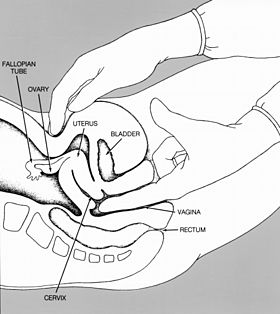Pelvic examination
| Pelvic examination | |
|---|---|
| Intervention | |

Line drawing showing palpation in pelvic exam.
|
|
| ICD-9-CM | 89.26 |
A pelvic examination, also known as a pelvic exam or vaginal exam, is a physical examination of the female pelvic organs. Broadly, it can be divided into external examination and internal examination. It is also called "bimanual exam" when two hands are used and "manual uterine palpation" (palpation meaning an examination by touch). It is frequently used in gynecology.
It is unclear if routine pelvic examination, outside of cervical cancer screening and screening for gonorrhea and chlamydia infections, is beneficial or harmful in those who are non-pregnant and do not have symptoms.
Use of a speculum to locate the external cervical os. Examination for foreign bodies and cervical swabs are taken at this point in the exam. These swabs of the epithelium layer of the cervix are known as a Pap smear. Other vaginal swabs can be taken at this time to test for sexually transmitted diseases.
Two fingers are inserted into the vagina until they isolate the cervix. Then the health care professional tests for cervical motion tenderness, as classically seen in pelvic inflammatory disease. The examiner presses down on the abdomen with the external hand, to locate the fundus of the uterus and the adnexal structures.
The exam should not be excessively uncomfortable, but a woman with a vaginal infection or vaginismus may feel pain when the speculum is inserted. Using the smallest available speculum may help. A woman with an untreated imperforate hymen may find it impossible to be examined. During the bimanual exam, the palpating of the ovaries may be painful. The pap smear may cause some cramping as well.
...
Wikipedia
